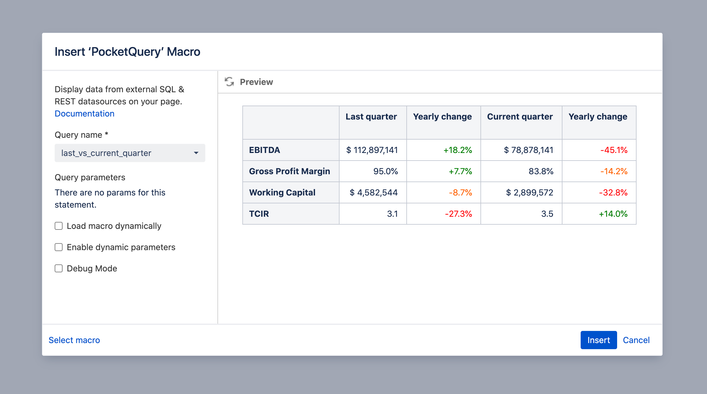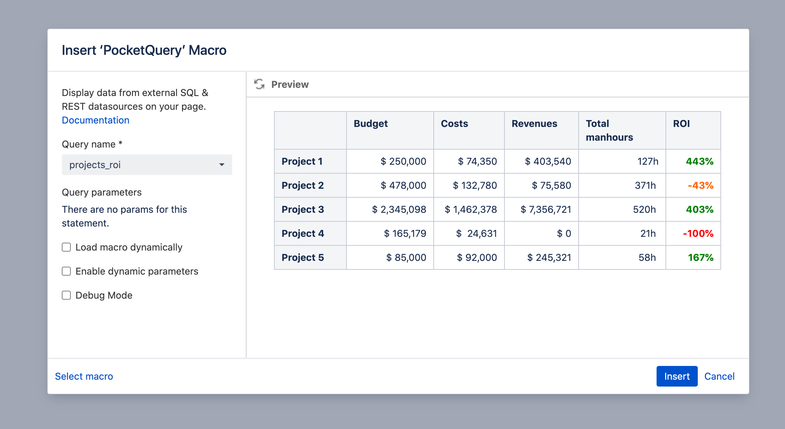Community resources
Community resources
How to build secure financial reports in Confluence
Creating enterprise connections to Confluence
Confluence is a great platform to publish knowledge you want your employees to quickly find and respond to.
This usually includes employee guides, product documentation, Help Center articles. It has the potential to include also company KPIs, team and personal OKRs, and similar business metrics if you complement it with the available options in the marketplace.
Take PocketQuery by Lively Apps, for example. You can quickly create reports using your most accurate company data on any given topic. The great advantage is that the reports will be dynamic. Define your business need, create it, enjoy it!
Where can data come from? You name it: ERP. CRM. Business Intelligence. Or Jira itself. In the API economy, it's always a good idea to integrate two applications that combine their strengths.
Use case: accounting information on Confluence for non-financial employees
If you ask someone who works in finance how often they're asked to share information internally, they will tell you this is literally their job description. Finance is a service function.
Bottom up, financial information gives the global overview of how the company has performed and is forecasted to perform in the future.
Top down, many employees whose performance is tied to financial goals want to know whether their efforts are moving the needle in the right direction. The entire Sales and Marketing areas fit into this description.
Let's have a look at two examples of dynamic reports on Confluence: one for the Steering Committee, and another one for project managers or for the PMO more generally.
Creating an executive dashboard in Confluence
The C-club enjoys simple reports that give an accurate overview. A report like the one below can also be shared with the entire company, with the great benefit that it will always show the information from the last two quarters without any additional work that your finance team is not already doing.
Of course, the KPIs included here can vary depending on the industry. I have included TCIR (Total Case Incident Rate) because it's an important safety KPI in manufacturing companies, particularly in times of change when new processes are being implemented, new machinery is introduced, etc.
Note: the table below contains entirely fictional data.
General managers know that a company is healthy or unhealthy just by looking at these numbers. In the example above, the trend in working capital shows that our customers are not paying us in a timely manner. To solve the problem, you will need to drill down into the details, but a first alarm can be spotted quite promptly from the executive dashboard.
In the example, it seems like the company has been hit quite hard on the earnings front by the COVID lockdown, but a second look at the margin indicates that it's done an incredible job at restructuring costs.
Creating a project dashboard in Confluence combining data from your ERP and Jira
Project-based organizations can easily combine timesheet and productivity information from their task management application, like Jira, with their ERP.
Remember that all this information is not a snapshot: it's dynamic.
Feeling inspired? You can read this guide to find out how to query REST API resources to build reports like this.
It shouldn't be hard to adapt it to product-based organizations to include, for example, time worked and support information from Jira, combined with the key business metrics for each product.
4 recommendations for secure API connections
How comfortable are you transmitting the most confidential information about your company's performance from your cloud applications over the internet? When it comes to financial data, it's extremely important to secure the integrations you're creating between Confluence and other external applications. The impact of a leak can be huge!
Here are the 4 key recommendations that you should follow to avoid trouble:
- Always make sure you're using an https URL to access your data sources so that the information is encrypted
- Don't reinvent the wheel. Trust products for Confluence or existing connectors to build your reports rather than create a plugin to automate the queries. An in-house product will be difficult to maintain, unstable in the long run, and will increase the risk of vulnerabilities.
- Whenever possible, replace personal passwords with API Tokens. If you're getting data from the Jira API for example, you can use resolution's API Token Authentication for Jira (for full disclosure, resolution is my current employer).
- If you are already using a Web Application Firewall, make sure to whitelist API connections.
Was this helpful?
Thanks!
Capi [resolution]

About this author
Inbound Marketing | Thought Leadership
Resolution
Berlin, Germany
19 accepted answers
Atlassian Community Events
- FAQ
- Community Guidelines
- About
- Privacy policy
- Notice at Collection
- Terms of use
- © 2024 Atlassian








0 comments